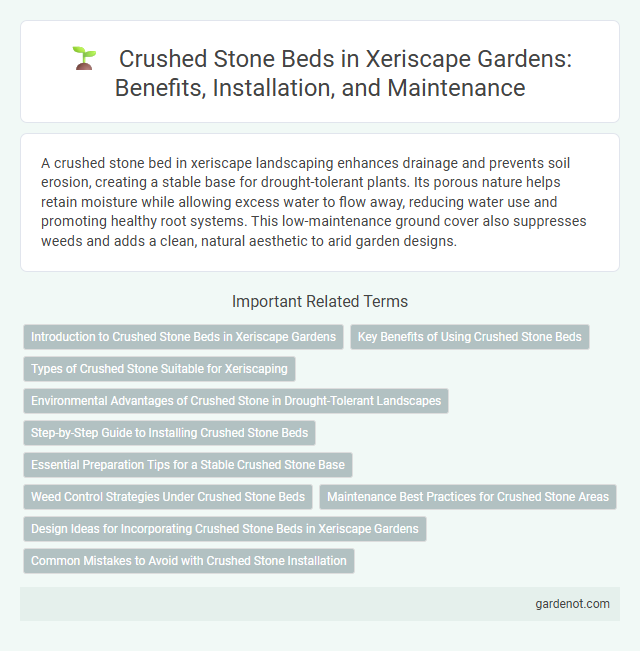A crushed stone bed in xeriscape landscaping enhances drainage and prevents soil erosion, creating a stable base for drought-tolerant plants. Its porous nature helps retain moisture while allowing excess water to flow away, reducing water use and promoting healthy root systems. This low-maintenance ground cover also suppresses weeds and adds a clean, natural aesthetic to arid garden designs.
Introduction to Crushed Stone Beds in Xeriscape Gardens
Crushed stone beds in xeriscape gardens provide excellent drainage and help retain soil moisture, reducing the need for frequent watering. These beds create a durable, low-maintenance surface that suppresses weed growth and enhances the visual appeal of drought-tolerant landscapes. Incorporating crushed stone into xeriscape design supports sustainable gardening practices by conserving water and promoting soil health.
Key Benefits of Using Crushed Stone Beds
Crushed stone beds provide excellent drainage, preventing water accumulation that can damage plant roots in xeriscape gardens. Their porous structure reduces soil erosion and retains moisture efficiently, supporting drought-tolerant plants. This durable, low-maintenance ground cover also minimizes weed growth, promoting a healthier, more sustainable xeriscape landscape.
Types of Crushed Stone Suitable for Xeriscaping
Crushed stone beds in xeriscaping often utilize materials like limestone, granite, and quartzite due to their durability and drainage properties. Limestone's light color reflects heat, while granite offers hardness that resists erosion, making both ideal for sustainable water-efficient landscapes. Quartzite's resistance to weathering enhances soil protection, ensuring stable ground cover in xeriscaped gardens.
Environmental Advantages of Crushed Stone in Drought-Tolerant Landscapes
Crushed stone beds significantly reduce water consumption by minimizing soil evaporation in drought-tolerant landscapes, promoting sustainable water use. Their permeability enhances natural groundwater recharge while preventing runoff and erosion, supporting healthier plant growth without excess irrigation. Utilizing crushed stone also eliminates the need for chemical treatments or fertilizers, further protecting local ecosystems and reducing environmental impact.
Step-by-Step Guide to Installing Crushed Stone Beds
Prepare the site by clearing vegetation and leveling the ground to create a stable base for the crushed stone bed. Lay landscape fabric to prevent weed growth and improve drainage, then spread a 2-4 inch layer of crushed stone, ensuring even distribution and compacting it with a tamper or roller. Finish by edging the bed with metal or plastic borders to maintain shape and prevent stone displacement.
Essential Preparation Tips for a Stable Crushed Stone Base
Establishing a stable crushed stone bed begins with thorough site excavation to remove topsoil and organic material, ensuring a solid foundation. Compaction of the subgrade using a vibratory plate compactor minimizes settling and enhances stability. Applying a geotextile fabric layer prevents weed growth and separates the crushed stone from soil, optimizing drainage and structural integrity.
Weed Control Strategies Under Crushed Stone Beds
Crushed stone beds provide an effective barrier for weed growth by limiting soil exposure and reducing moisture retention, which inhibits weed seed germination. Incorporating a high-quality, permeable landscape fabric beneath the crushed stone further enhances weed control by blocking weed roots while allowing water drainage. Regular maintenance, such as occasional topping of crushed stone and removal of debris, ensures long-term effectiveness in preventing weed infestation.
Maintenance Best Practices for Crushed Stone Areas
Regularly removing debris and weeds from crushed stone beds prevents unwanted plant growth and maintains a clean appearance. Replenishing the crushed stone layer every 1-2 years helps to retain proper drainage and surface stability. Applying a weed barrier fabric underneath the stones significantly reduces maintenance efforts and prolongs the bed's functionality.
Design Ideas for Incorporating Crushed Stone Beds in Xeriscape Gardens
Crushed stone beds enhance xeriscape gardens by improving drainage and reducing soil erosion while providing a low-maintenance mulch alternative. Design ideas include creating contrasting pathways with light-colored crushed granite or integrating decorative stone borders around drought-tolerant plants like succulents and native grasses. Using varied stone sizes and colors adds texture and visual interest, complementing the natural desert aesthetic.
Common Mistakes to Avoid with Crushed Stone Installation
Common mistakes to avoid with crushed stone installation in xeriscaping include improper base preparation, leading to poor drainage and uneven surfaces. Using stones that are too large or irregular can cause discomfort and reduce aesthetic appeal. Failing to install edge restraints often results in stone migration, undermining the stability of the crushed stone bed.
Crushed stone bed Infographic

 gardenot.com
gardenot.com